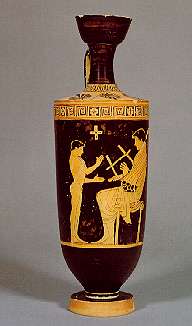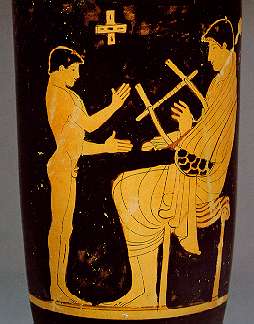 |
 |
4. The mythology of musical reminiscence
The silence of oblivion, exemplified by the fate of Thamyris, cancelled a heritage of knowledge existing at different levels and expressed in various ways. First of all, it broke forever the chain of transmission - based on the father/son relationship - of individual, familial, and social memory, a common wealth carried in the mind of the singer. This thread of transmission, which is common also to other ancient musical cultures of the Mediterranean, e.g. the Assyrian-Babylonian (Spycket 1972) and Egyptian ones (Hdt. VI.60), unraveled in Greece along two interchangeable planes of mythological and historical reality (Veyne 1983): the origin of singing to the aulos was ascribed, through Hyagnis and Marsyas, to Olympus and then Hierax; singing to accompaniment of the kithara was ascribed to Thaletas, Terpander and Archilochus. While Olympus and Thaletas must be considered, in Abert's definition "collective legendary names", Terpander and Archilochus represent the historical roots of the lineage of Greek composers (Abert 1910). This way of merging exemplary memories and mythicized truth finds a precise correspondence in the genealogies of players of folk music (for instance, the Sardinian players of launeddas, Bentzon 1969), where the origin of an illustrious "school" is placed in remote antiquity. In parallel, albeit in a rather exceptional way and rooted only in particular places and at particular times, the organization of both the guild of Homeric rhapsodists and groups of instrumentalists adopted behavioral models typical of kinsmen, even though the blood-relationship existed only in a few cases. But the important point is that the spiritual relationship between teacher and pupil created bonds comparable to those of blood-relationship (Cāssola 1988). The model of father and son was common to entire "schools" of musicians (as well as to heralds and cooks): one thinks of the Spartan auletai still in the early fifth century BC, or the descendants and successors of the family of Pronomus and Antigenidas, in Thebes, who had no solution of continuity from the fifth century to the second century BC (Roesch 1989).
 |
 |
Music lesson. Attic red-figure lekythos, 480-470 BC. Private collection.
In such a system, the role of the parent/teacher, family/corporation, or even of the entire community consisted in preserving the collective memory, in exerting direct control on the successive repetitions of transmitted songs, melodies, rhythms and gestures, and in intervening, if necessary, in order to fill in gaps and to correct errors and changes arising from individual memory. Should the group's memory fade away, the content of the group's songs would be lost too. Ultimately, this content represents a fragment of the collective identity of that group or polis, based on myths of the origin and on a shared heritage of stories of heroic deeds or witnesses of the genealogical prestige of the dominant family.
At a further level, the loss of collective memory implied the loss of that most intangible function of "interior coordination" that was an indispensable part of Greek poetical creation. In the Archaic age, this function was defined according to the paradigm of the material/craft culture developed in the polis. In this context mousike was verbally described as the necessary techne to combine text, music and movement, though the process of selection among linguistic-thematic and rhythmic-musical options, that aimed to find connections useful in composition. According to this view, the musician was considered as the technites, who was able to combine sound and images through the use of his voice, gestures, dance, and instruments; when the musician organized a chorus, he also ruled all aspects of the accompaniment on the aulos or kithara, in addition to coordinating words, music and movements. In a perspective that considers the mousike as techne, and ancient Greek musicians not too far removed from musicians in Jewish and Muslim art music (Shiloah 1997), memory should be seen both as the most solid link with the traditional values contained in the songs, and the invisible means of transmission of technical knowledge.
The contest, whose archetype was Thamyris' challenge, represents the means created by the Greeks of the archaic age in order to recognize excellence in the field of music. This excellence was connected with the ability to express the values of the polis; it was not required for the music used for religious and aesthetic purposes. This explains why, from the viewpoint of the archaic polis, the challenge of the itinerant player to anyone willing to participate in the kitharodia (Muses included), developed into a reference model for the professional musicians who transformed the musical contest into an event reinforcing the civil and political traditional values of the city. In Athens of 430 BC, i.e., in a radically different socio-political and cultural context, these values were considered to be under the patronage and protection of the Muses and were preserved through the "control" of collective memory (Barker 1990). Therefore, it is not surprising to see the Muses often associated with Apollo not only in texts, but also in a series of images devoted to musical education, such as the cups of the so-called painter of Calliope, that portray scenes of libation and teaching with both gods and humans (Queyrel 1988). The Muses, daughters of Memory/Mnemosyne, guaranteed the control of the collective memory and therefore the safeguard and maintenance of the traditional methods and values spread by mousike, including the debarment from what is a divine gift (Barker 1994).
The need to preserve intact the musical text and its rhythmic-gestural components, accepted by both the individual and group - deliberately or not - seems common to many ancient and modern traditional societies. The accuracy of the recollection is an important part of the attitude towards performance that is typical of some Mediterranean vocal repertoires of oral tradition like, for instance, the Cretan rizitiko (Magrini 1992). The "length of the journey" (Barba 1993), that allows the music of ancient Greece to be placed alongside other ancient and contemporary musics mainly of oral tradition, is consentaneous to the methods and purposes of ethnomusicology.
Coming back to ancient Greece - back "home" as it were - one should recognize that the role of Memory/Mnemosyne in the mythology of archaic Greece - a role of preserving, transmitting and repeating myth (Vernant 1959; Havelock 1963), seen as the foundation of all knowledge - is paralleled by a similar role played by mousike - that of conserving, transmitting and repeating sound. Thus, the "invention" of the mythology of reminiscence could and does contain an unsuspected "richness": the mythology of musical reminiscence.